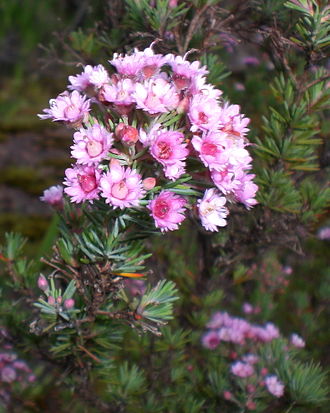Verticordia

Verticordia is a genus of more than 100 species of plants commonly known as featherflowers, in the myrtle family, Myrtaceae. They range in form from very small shrubs such as V. verticordina to trees like V. cunninghamii, some spindly, others dense and bushy, but the majority are woody shrubs up to 2.0 m (7 ft) tall. The flowers are variously described as “feathery”, “woolly” or “hairy” and are found in most colours except blue. They often appear to be in rounded groups or spikes but in fact are always single, each flower borne on a separate stalk in a leaf axil. Each flower has five sepals and five petals all of a similar size with the sepals often having feathery or hairy lobes. There are usually ten stamens alternating with variously shaped staminodes. The style is simple, usually not extending beyond the petals and often has hairs near the tip. All but two species are found in Southwest Australia, the other two occurring in the Northern Territory.
The first scientific collection of verticordia specimens was made in 1791 and the first formal description of a verticordia was written in 1826 but the name Verticordia was not used until 1828. Alex George undertook a revision of the genus and in 1991 published a paper describing three subgenera, 24 sections, and 102 species.
Verticordia species occupy a wide variety of habitats, with some species widespread and abundant whilst others are rare and endangered. The profuse and striking display of intricate flowers of many species has led them to being harvested for floristry or simply admired as a wildflower.
The genus is best known for its flowers, often described in superlatives, which form massed displays in woodlands and heaths. These shrubs have appealed to amateur collectors and botanists, and were appreciated by the peoples of Australia before European settlement. The fringed or feathered appearance of the flowers is often enhanced by vivid and contrasting colours: this has given a common name for the genus, featherflower.[1] The variety displayed within the species, and between species in the genera is highly diverse.
V. chrysantha in Kalbarri National Park
Painting by Ellis Rowan; V. grandis, V. huegelii, V. brachypoda
The genus is part of the family Myrtaceae which exist, predominantly, in the southern hemisphere. The family was highly successful in southern Jurassic Gondwana, remaining as the highly diverse tree and woody shrub genera found in Australia. Verticordia are native to Western Australia and the Northern Territory, and are closely related to Chamelaucium, Rylstonea, and Darwinia. The genus Homoranthus, found in other states of Australia, contains two species previously supposed to be Verticordia.
The single flowers are often presented erect, these may be supported individually or grouped into tight displays of various arrangements. They may appear in succession or at once. The colour often varies as the flower ages, further adding to a painterly effect. The sepals are divided into lobes, with the exception of Verticordia verticordina, in a variety of thread-like or feathery forms. The colour of the sepals and petals is highly diverse, it may be solid, or variable, or mutable.
These may be of several colours, or solid, the striking combinations are of all colours except blue. There is no unisexual flowers in the species. Different species may be growing together, their massed displays creating painterly contrasts in flowering landscapes.
They are highly variable in appearance, often as a woody shrub, low or up to 2 metres, two tropical species are 7 metres. Branches may be upright or splayed out, sometimes pendulous, and are tightly or sparsely arranged. Leaves are very small or medium, scattered or opposite, and might be ciliated at the margin. The leaf shape is highly variable across, and these may differ at the base and floral leaves on individuals.
Hybrids of different species have been recorded and identified. A variant, known as ‘Eric John’, appears to be an intergeneric cross between V. plumosa and Chamelaucium floriferum.[2]
